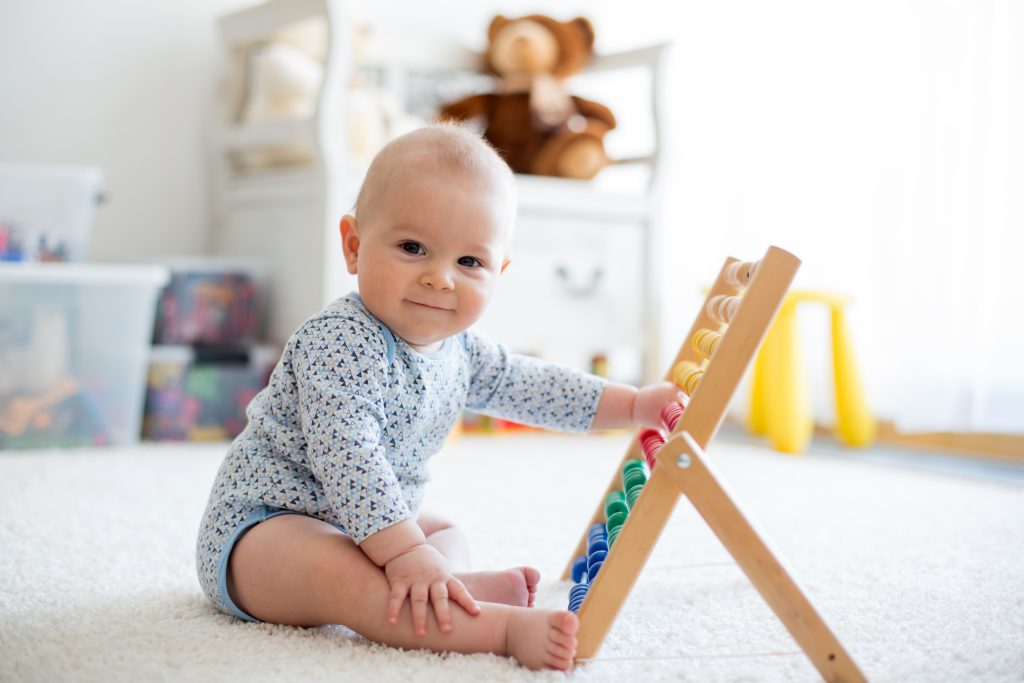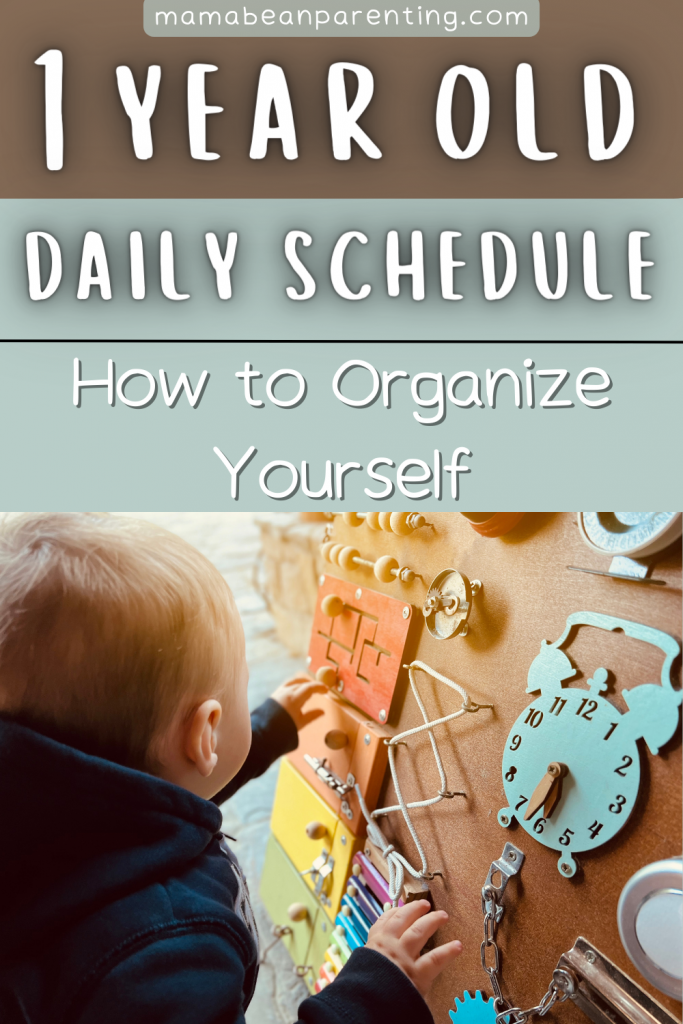Figuring out a 1 year old daily schedule is probably not the hardest thing you have to deal with right now, because, to be honest, you’ve gone through the worst things in the meantime, right, such as childbirth, adapting to the little one (and his/her habits), etc.
Therefore, determining a 1-year-old-daily schedule shouldn’t be as challenging. After all, now you know your baby so much better, so it’s going to be much easier to establish a 1-year-old-daily schedule.
Generally speaking, every mom knows that during the first year, most things revolve around a 12-month-old nap schedule and eating schedule.
But the good news is things won’t be drastically different right now when it comes to a 1-year-old daily schedule and other aspects of your baby’s life.
So if you are ready for the next chapter (regarding a 1-year-old daily schedule), below I’ll properly prepare you for everything (because 1-year-old kids and I are besties, so we get along perfectly!).
Many Reasons Why You Should Establish A 1-Year-Old Daily Schedule

Even though you may be intimidated by the things that will be happening during this period of time due to some changes that will happen, don’t worry.
These changes are not going to be so dramatic, and your little one will quickly adjust to everything in terms of eating and sleeping.
Therefore, you shouldn’t be too scared of creating a 1-year-old daily schedule. Yes, at first you most likely won’t be able to extend your morning nap, but that won’t last forever.
Let’s focus on the bright side of everything. Just think, your baby is turning one! They are so close to becoming a toddler (a person who will no longer say only gugu gaga) meaning they’ll most likely have three meals a day, which is great!
So instead of constantly worrying, it would be so much better to concentrate on a 1-year-old daily schedule, because that’s something that will help you establish a feeding schedule for 1 year old and a 12-month-old nap schedule.
So what are the benefits of it?
1. Much better sleep patterns will positively impact the baby’s development and health
2. You’ll be much more flexible in terms of organizing your day
3. You won’t be as tired as you were up until recently
4. Babies (& toddlers) in general adore when their routine is established
Major Components of a Superb 1-Year-Old Daily Schedule
When focusing on developing a great 1-year-old daily schedule, then you should take these things into account:
1. Wake-up time
2. 12-month-old nap schedule
3. Structured playtime
4. Play time when your child plays independently
5. Feeding schedule for 1-year-old
6. Free time
7. Bedtime
When it comes to wake-up time and bedtime, it’s up to you to decide what suits you most.
What I’ve heard so far (concerning a 1-year-old daily schedule) is that most moms opt for either 7 am wake-up time and 7 pm bedtime or 8 am wake-up time and 8 pm bedtime for their soon-to-be-toddler.
However, if that doesn’t work for you at this very moment, you can always create a different 1-year-old daily schedule.
Just keep in mind that this doesn’t necessarily mean (even when you establish a 12-month-old nap schedule) that your baby will sleep the entire time.
But at the end of the day, that doesn’t really matter. What matters is that your kid is properly relaxed.
Speaking of a 1-year-old daily schedule, just make sure to keep wake-up time and bedtime around twelve hours apart.
When Is the Best Time To Incorporate Structured Playtime and Independent Playtime into a 1-Year-Old Daily Schedule?

A vast majority of babies have the best focus and are capable of playing early in the morning. If that currently doesn’t suit you, then opt for the time after the afternoon nap.
I personally think that these sorts of activities are best right after breakfast or immediately after a snack and afternoon nap.
It would generally be great if your little one plays on their own for approximately thirty minutes each day.
Should There Be One or Two Naps A Day?
Figuring out a 12-month-old nap schedule can be confusing to some mothers because they can never be sure whether one nap is enough for their child.
So what’s the final answer to this question?
When it comes to determining a 12-month-old nap schedule, keep in mind that both one and two naps are perfectly acceptable.
After all, in these instances, everything depends on your baby and its need for napping.
Around this age, when becoming toddler, is when a vast majority of babies start having one nap each day. But this rule definitely doesn’t apply to every baby.
Namely, some of them will change their habits before they become toddler, and yet, there are those who will stick to them until they are two years old. You can never predict these things.
Now, the question is, what influences a 12-month-old nap schedule?
To be honest, there are various factors that can impact a 12-month-old nap schedule, such as the schedule of your family, your little one’s temperament, and many other things.
But how will you know whether your baby is ready for a single nap or not?
Fortunately, there are a variety of different signs that will tell you that it’s time to modify a 12-month-old nap schedule, and they include:
1. Your toddler is no longer interested in having scheduled naps
2. It takes a lot of time for your child to fall asleep at night
3. Your little one wakes up early in the morning
4. Pushes bedtime unreasonably late
So when can you expect a 12-month-old nap schedule to alter? According to some mommies, many babies will start showing these signs when they are 11 to 16 months old.
However, as I’ve already stated, every baby is different, meaning there’s not a single rule when it comes to a 12-month-old nap schedule or a 1-year-old daily schedule.
The best way to fortify what your little one truly wants is to simply pay attention to the signs I previously mentioned.
If you notice any of them, then maybe it’s time to stop with two naps and start implementing only one.
Mid-1-Year-Old Daily Schedule – Excluding the Nap

The next step is to dive into the mid-1-year-old daily schedule. So if you’ve noticed that your baby has shown any of the signs I mentioned above, then it’s time to exclude the nap.
Bear in mind that it’s not something that happens overnight, but don’t worry, you’ll get there sooner than you think.
At the end of the day, your little one got used to having a morning nap for the first year of their life, that’s why it may be a bit challenging at first. But just pay attention to the baby’s cues.
Even though most babies will be completely fine with dropping the nap cold turkey, don’t forget that they will still need some time to adapt.
They will need to try to accept the fact that they “must” stay awake until the afternoon nap.
So how can you drop the morning nap then?
Don’t worry! It’s not as difficult as it may appear to be at first glance. Below, I’ll share some tips that will help you accomplish that in a blink of an eye!
1. Push back the typical morning nap fifteen minutes later, waking your kid at the same time as normal
2. Push your child down for a morning nap at the same time, but be sure to wake him/her up before he/she would normally wake. For instance, if your baby sleeps approximately 2 hours, wake him/her up after 1.5 hours.
3. It would be great to take your little one out early in the morning (when the nap is “scheduled”) so you can keep him/her awake.
As soon as you come home, feed your baby and then prepare him/her for sleeping.
So for example, instead of 10:00 am and 1:00 pm nap times, ensure to keep your baby up in the morning and then put him/her down at around 12:00 pm.
In these instances, pay attention to the napping, to see how long your little one sleeps during that nap. If it’s not as long, then you will have to move up to bedtime.
4. Your kid shouldn’t sleep more than thirty minutes (referring to the morning nap). The next nap should be immediately after lunch, at 1:00 pm.
5. As I stated previously (when speaking about a 12-month-old nap schedule), your baby may need some time to adjust to these changes, but it will happen at some point, don’t worry.
If you tried dropping the morning nap and you notice that your child is already very tired by early evening, then it would be advisable not to exclude a morning nap, at least until your baby is one hundred percent ready for it.
Moving On to Later 1-Year-Old Daily Schedule – One Nap

Your little one will most likely be ready to stop having the morning nap. And that’s something that will surely give you some relief because you won’t be forced to be at home every single morning so your kid can sleep.
On the other hand, you may find it a bit challenging, because you’ll have to think about activities you must do to fill the new time with your child.
Fortunately, babies are not as demanding as older kids, so you don’t have to entertain them. Just give them something to play with.
These are the things that you can do to completely exclude the morning nap:
1. In the beginning, you will most likely need to have the afternoon nap time moved up a bit.
But not too early. If your baby loves napping at 10″30 am for instance, then you should move the nap up to 11:30 am or 12 pm, and then slowly move nap time back to 12:30 pm.
2. Speaking of the sleep schedule, expect your little one’s nap to prolong. However, it’s not going to occur instantly.
Generally speaking, afternoon naps (referring to 18 months old children) can be pretty long, up to 4 hours. However, this won’t last forever and may in time become shorter.
3. Make sure your baby eats very well (, particularly during dinner, if you want your kid to sleep at night and not wake up early ) to keep the tummy full because that leads to firmer and deeper sleep.
4. If by any chance, your little one wakes up after 40 to 45 minutes, be patient. Do not panic immediately. Your baby will most likely go back to sleep very quickly.
Let’s Discuss Feeding Schedule For 1-Year-Old

Now, that I’ve discussed various aspects of sleep schedules, it’s time to blast off this topic. At this age, kids love eating three times a day and are no longer interested in breastfeeds and/or bottles.
Of course, this doesn’t necessarily mean that you will no longer breastfeed. For instance, a lot of mummies still breastfeed their babies in the morning and potentially at night.
And then, there are those babies who love to snack during the day. Now, if your little one is bottle-fed, then there’s no need to opt for follow-on milk.
How come?
Well, that’s because a vast majority of healthcare providers think that this product is completely redundant.
Once your baby turns one, you can use full-fat milk in the morning and afternoon, however, make sure (this refers to the rest of the day) your child drinks lots of water.
Not only is this beneficial for their teeth, but for their overall well-being as well!
Many kids love having a snack either in the mid-morning or during the mid-afternoon.
So what are the best options when it comes to this?
Pitta bread, breadsticks, carrot sticks, and fruits are generally the best option. Nowadays, you can easily stumble upon excellent meal ideas that are perfect not only for a 1-year-old but for a baby toddler too!
Now, if by any chance, you are still having issues with solid foods, then don’t forget to be persistent in terms of offering meals and reducing milk feeds.
It may be hard for you in the beginning, but don’t worry; you’ll get there very soon. Just be persistent and do not allow your little one to be more stubborn than you.
Let’s Add More Details Regarding Playtime

I know that I previously mentioned some things concerning playtime, but I would like to discuss it more down below.
Most parents know that babies can be pretty hyperactive during this period of time. They want to explore everything, learn how to walk, and even climb (to satisfy their curiosity).
And that’s something that can be frightening to new parents.
But do not obsess over it too much. Remember that playtime (or any form of entertaining activity) is very important for your kid (particularly for their development) and must be part of his/her daily routine.
So when is the best time to have an amusing time with your child?
I would say it’s morning. That’s because they turn into a huge energy bomb that can turn the world upside-down.
So if you want to ensure your little one has the time of his/her life, be sure to take him/her to the park, or, why not, swimming?
If your kiddo decides to take an afternoon nap, then you won’t have too much time on your hands to take him/her out.
So what to do in these types of situations?
That’s the ideal time to welcome his/her favorite toys or focus on crafting.
These activities are a perfect way for your child to express his/her creative side, and, at the same time, have loads of fun while playing in his/her room.
If you’re looking for something that’s going to amuse your kid, yet simultaneously suppress his/her hyperactivity, then I suggest opting for blocks.
Namely, building something with them is a great way to do something creative and enjoyable, plus it’s going to calm your baby down and prepare him/her for sleeping.
On the other hand, if it’s too early for bed, yet you want to have an activity that’s ideal for an overactive child, then there’s always an option for the two of you to play hide and seek. Peek-a-boo!
And Then There’s Bedtime

Did you establish a bedtime routine with your little one? If you didn’t, now is the best time to do so.
Fortunately, a bedtime routine for a 1 year old isn’t significantly different than the one you had when your child was just a baby, although it’s quite different if you compare it with a toddler’s (since a toddler’s schedule is a bit different).
You’ll notice that your kid is much more concentrated when you’re reading a book to him/her which is a great thing.
It would be great if you read your baby much longer now because that will affect his/her language skills positively.
So what are the best books for bedtime?
It would be advisable to opt for calmer books before bedtime, and the ones that are “louder” leave for an afternoon nap or any other part of the day.
After all, you don’t want your little one to go to sleep while moving its feet like he/she is on the dance floor.
Generally speaking, you’ll be able to easily establish a bedtime routine, but just be patient because it’s going to take a while, a week or so.
Conclusion

A 1 year old daily schedule is a pleasant (and a bit overwhelming) change to a mom’s life (oh, and dad’s too).
However, as you can see, you do not need to make any serious modifications in order to make your baby happy.
Ultimately, it’s widely known that most adults thrive on schedules, so I genuinely believe that your little angel will bloom as well!
I’m positively sure that you’ll excel at this! Let me know how everything turned out!

Well, hello there!
My name is Jennifer. Besides being an orthodontist, I am a mother to 3 playful boys. In this motherhood journey, I can say I will never know everything. That’s why I always strive to read a lot, and that’s why I started writing about all the smithereens I came across so that you can have everything in one place! Enjoy and stay positive; you’ve got this!



binance odkazov'y kód
Wednesday 5th of June 2024
Thank you for your sharing. I am worried that I lack creative ideas. It is your article that makes me full of hope. Thank you. But, I have a question, can you help me?
binance акаунтын жасау
Monday 25th of December 2023
Thank you for your sharing. I am worried that I lack creative ideas. It is your article that makes me full of hope. Thank you. But, I have a question, can you help me? https://www.binance.com/kz/register?ref=FIHEGIZ8
How to Make Breastmilk Fattier? • Mama Bean Parenting
Thursday 16th of February 2023
[…] It is widely known that babies grow fast, frequently tripling their baby weight, and growing around ten inches by their first birthday. […]